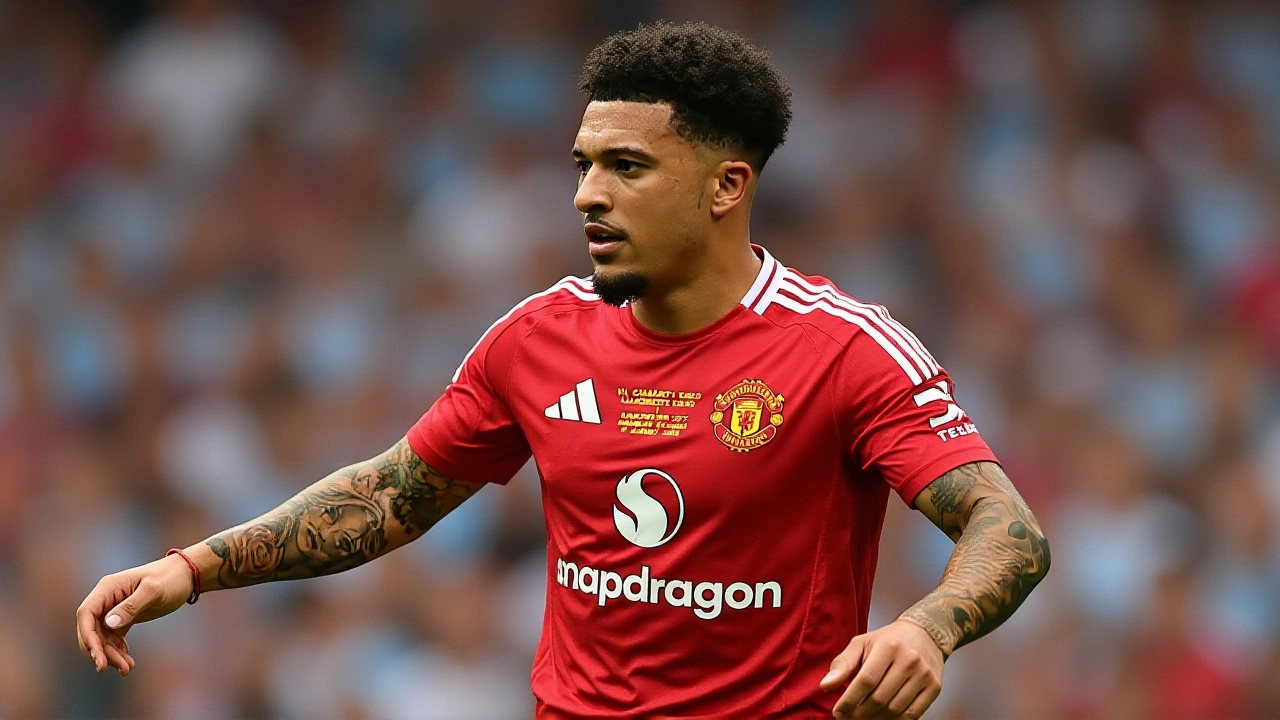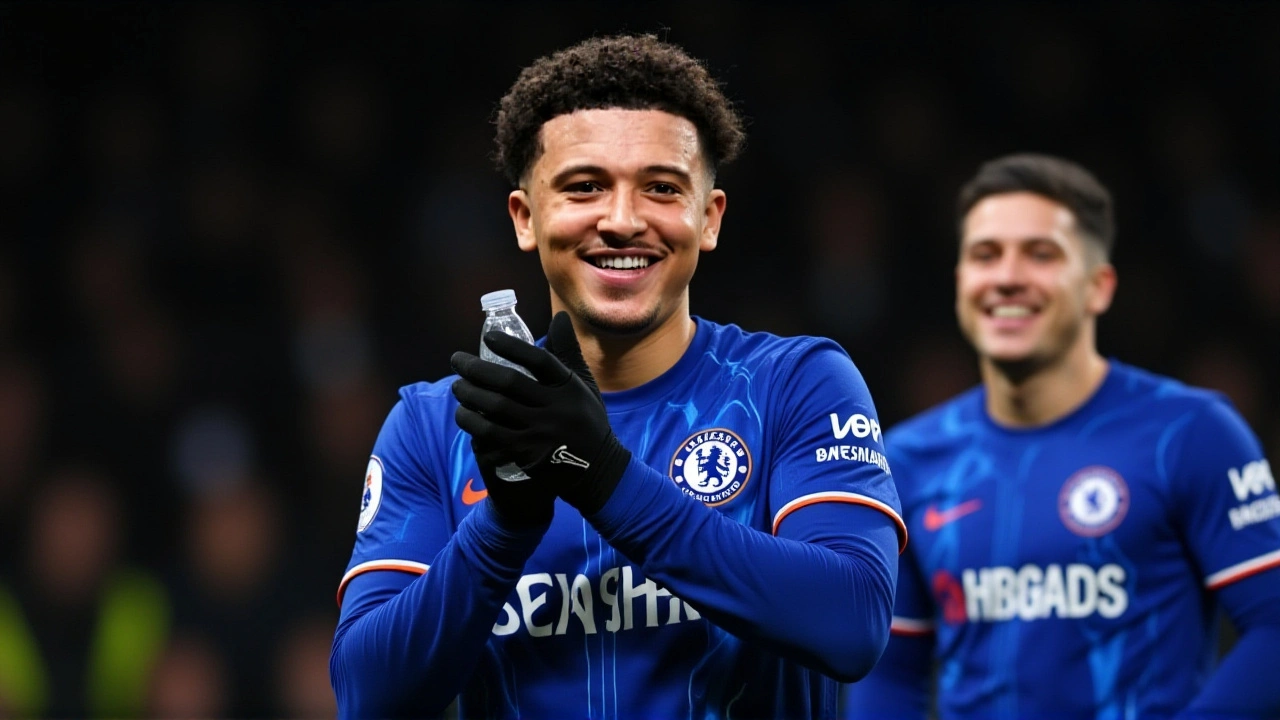8 Oct 2025
- 15 Comments
When Jadon Sancho, winger left Chelsea Football Club in June 2025, the move wasn’t a classic buy‑out – it was a £5 million penalty paid to Manchester United Football Club after the Blues refused to trigger a £25 million obligation‑to‑buy clause. The decision came down to personal‑term disagreements: Sancho, who was earning up to £300,000 a week at Old Trafford, was asked to take a significant pay cut that clashed with Chelsea’s wage structure under owner Todd Boehly. Here’s why the saga matters for both clubs and the wider transfer market.
Background: From Dortmund to Stamford Bridge
Sancho’s journey began in July 2021, when United splashed £73 million to sign the German‑trained English winger from Borussia Dortmund. The five‑year deal, with an option for a sixth, kept him under contract until June 2026 and made him one of the Premier League’s highest‑paid players. After a mixed spell at Old Trafford, he spent the 2024‑25 season on loan at Chelsea, racking up 41 appearances, five goals and 10 assists across all competitions.
His most memorable moment came in the UEFA Conference League final, where Chelsea routed Real Betis 4‑1. Sancho’s third‑minute strike helped secure the club’s first European trophy under Boehly’s ownership, a highlight that briefly painted him as a potential long‑term solution for the Blues.
Why the Deal Fell Apart
The loan agreement included a £25 million obligation‑to‑buy that automatically kicked in at the end of the season – unless the clubs could not agree on personal terms. Chelsea’s finance team, still calibrating a £600 million wage bill, offered Sancho a contract that would see his weekly earnings drop to roughly £150,000, a figure far below the £300,000‑plus he was already making at United.
Sancho’s camp pushed back. Sources close to the player say his agents insisted on a salary no lower than £250,000 per week, citing market‑rate wages for top‑level wingers. When negotiations stalled, Chelsea chose the cheaper route: they paid United a £5 million penalty – a clause that had been inserted in the loan contract to cover exactly this scenario.
Immediate Reactions from the Clubs
Upon his return, United manager Ruben Amorim placed Sancho in a specialised training group colloquially dubbed the ‘bomb squad’, alongside Marcus Rashford, Tyrell Malacia and Antony. The squad trains separately at Carrington, away from the first‑team routine, a move that has raised eyebrows among fans.
Sancho posted a heartfelt goodbye on social media, thanking Chelsea staff, teammates and supporters. "Grateful for the experience. Big love to everyone at Chelsea who made me feel at home," he wrote, underscoring the professionalism that has characterised his short stint at Stamford Bridge.

Potential Suitors and the Salary Conundrum
European interest has been steady. Italian side Roma reportedly agreed a base fee of €19 million (£16.4 million) with United, rising to €24 million with add‑ons, but they have yet to lock down personal terms. Juventus and Borussia Dortmund – his former club – are also circling, yet according to journalist Graeme Bailey, “Sancho has made it clear he will only move on his terms.”
The sticking point remains his wage demand. Even a club like Roma, whose average wage bill sits near £200,000 per week for star players, would have to stretch to meet Sancho’s £250,000‑plus request. Dortmund, flush with Champions League revenue, could potentially meet that figure, but the player appears reluctant to compromise.
What This Means for Manchester United
United now face a contract that expires in June 2026, with Sancho still on a lucrative deal. The club could either: (1) keep him on the bench and absorb the wage, (2) negotiate a new loan – perhaps mirroring the Chelsea arrangement where the loanee club subsidises part of the salary, or (3) sell him at a reduced fee to recoup some of the £73 million outlay.
Financial Fair Play considerations add pressure. Off‑loading a player earning £300,000 per week without a significant transfer fee would hurt United’s balance sheet, but retaining a disgruntled talent could also affect squad harmony.
Chelsea’s Next Moves
While Sancho’s exit leaves a creative gap, Chelsea’s scouting network remains active. The club has reportedly earmarked Borussia Dortmund’s 20‑year‑old winger Jamie Gittens as a potential replacement. Gittens, a left‑footed attacker with a proven goal‑scoring record in the Bundesliga, fits the profile of the next‑generation talent Chelsea hopes to integrate.
Alongside Gittens, the Blues are monitoring a list of eight to nine attacking options, ranging from established Premier League stars to emerging talents from the Southern European leagues. The ultimate target will need to align with the club’s wage bandwidth and the strategic vision of Sporting Director Michael Emenalo.

Broader Implications for the Transfer Market
This episode underscores a growing trend: clubs are embedding penalty clauses in loan deals to safeguard against wage disputes. It also highlights how player power – especially for high‑earning stars – can shape outcomes, even when clubs hold contractual leverage.
For the Premier League, Sancho’s case may prompt a reassessment of wage structures, as clubs seek to balance star salaries against a tightening financial landscape post‑COVID‑19.
What’s Next for Sancho?
In the coming weeks, Sancho is expected to engage in talks with his representatives and potential suitors. If a move materialises before the summer window closes on September 1, 2025, it could set a precedent for high‑salary players seeking flexibility. Otherwise, he may spend the season training with the bomb squad, awaiting a decision that could define the final year of his United contract.
- Penalty fee paid: £5 million
- Obligation-to-buy fee: £25 million (not triggered)
- Sancho’s weekly wage at United: ~£300,000
- Potential transfer fee range for Roma: €19‑24 million
- Contract expires: June 2026
Frequently Asked Questions
How does Sancho’s wage demand affect his transfer prospects?
Sancho’s request for roughly £250,000‑£300,000 per week narrows the pool of interested clubs. Only a handful of European teams, like Borussia Dortmund or high‑budget Serie A sides, can realistically meet that salary without breaching financial fair play limits, which explains why negotiations with Roma and Juventus have stalled.
What is the ‘bomb squad’ and why is Sancho placed in it?
The ‘bomb squad’ is a small, elite training group at Manchester United’s Carrington site, used for players needing individualized work. Sancho’s placement there, alongside Rashford, Malacia and Antony, signals that manager Ruben Amorim wants to keep him fit but is not ready to reintegrate him into first‑team plans amid ongoing contract talks.
Could Chelsea re‑sign Sancho later this season?
A re‑signing is unlikely in the short term because Chelsea already paid the penalty and their wage policy limits the salary Sancho demands. However, if United decides to off‑load him at a reduced fee, Chelsea might revisit him as a backup option, especially if their transfer targets fall through.
What does this deal mean for future loan agreements?
Clubs may increasingly insert penalty clauses to protect themselves from costly obligations if personal terms cannot be agreed. Sancho’s case illustrates how such clauses can provide a financial safety net while giving players flexibility, potentially reshaping loan structures across Europe.
Which clubs are most likely to sign Sancho before the summer window closes?
Borussia Dortmund, bolstered by Champions League earnings, tops the list, followed by Juventus if they can negotiate a joint‑wage arrangement. Roma remains in contention, but they must bridge the gap between their budget and Sancho’s salary expectations.


srinivasan selvaraj
October 8, 2025When Chelsea chose the £5 million penalty route, they signaled a new era of fiscal pragmatism. The club’s wage ceiling has been tightening like a pressure cooker ever since Boehly’s takeover. Sancho’s demand for a £250‑300k weekly salary is a glaring illustration of the widening gap between elite talent and club budgetary reality. In hindsight, the loan clause acted as a safety valve, preventing a potentially catastrophic £25 million outflow. Yet it also exposes how loan deals can become bargaining chips in a player‑power showdown. United, on the other hand, now carries a weighty contract that may hamper their financial Fair Play calculations. If they sit on Sancho as a bench‑warmer, the wage bill inflates without on‑field return. Conversely, a premature sale at a reduced fee could dent the £73 million investment they made three years ago. The broader market is taking notes: clubs are drafting penalty clauses to safeguard against personal‑term impasses. Such clauses, while financially protective, could unintentionally give agents more leverage, knowing that a club can simply walk away for a modest sum. Fans of both sides feel the sting of a decision made behind closed doors, yet the transparency of the penalty figure is a rare glimpse into the financial choreography of modern football. For younger prospects watching the saga, the message is crystal clear: wage ambition must be balanced against realistic club economics. The ripple effect may force the Premier League’s salary cap discussions to accelerate. Moreover, it could spur a trend where clubs embed “salary‑cap triggers” in future loan contracts. In the end, the £5 million penalty is a drop in the ocean of football finance, but it is a drop that creates waves. It reminds everyone that money, while abundant at the top, is still subject to careful allocation and strategic foresight.
Deepak Sonawane
October 8, 2025The contractual architecture here demonstrates a classic case of contingent liability modeling. By inserting a penalty clause, Chelsea effectively transformed a purchase obligation into a financial derivative that caps exposure. This move, while fiscally sound, underscores the asymmetry of power between club and player agents. It also sets a precedent for future loan structures across Europe.
Ravi Patel
October 9, 2025From a coaching perspective the ‘bomb squad’ setup gives Sancho the chance to stay sharp without disrupting the first‑team rhythm. It’s a pragmatic compromise that respects both the player’s professionalism and the manager’s tactical plans. United can monitor his fitness while negotiating the next step.
Piyusha Shukla
October 9, 2025Honestly, the whole penalty stunt feels like a PR rehearsal.
Shivam Kuchhal
October 10, 2025Looking ahead, Chelsea’s scouting focus on emerging talents like Jamie Gittens could restore creative balance without breaching wage policy. Targeting younger, high‑potential players aligns with a sustainable financial model and offers fans exciting prospects. Consistency in recruitment will be key to translating scouting reports into on‑field success.
Adrija Maitra
October 10, 2025Man what a rollercoaster for Sancho it's like watching a blockbuster thriller with twists at every corner. One day he's scoring in a final, the next he's stuck in a training group labelled bomb squad. Fans everywhere are feeling the drama and hoping for a happy ending.
RISHAB SINGH
October 11, 2025True that the drama adds flavor but staying fit is the priority for any player in his situation.
ANIKET PADVAL
October 11, 2025The wage‑disparity dilemma encapsulated by Sancho’s contract is emblematic of a deeper systemic fault line within elite football economics. On one hand, clubs are compelled to inflate salaries to attract marquee talent, while on the other they must adhere to increasingly stringent Financial Fair Play regulations imposed by governing bodies. This juxtaposition generates a paradox wherein a player’s market value can outstrip a club’s fiscal elasticity, leading to scenarios such as the £5 million penalty. The penalty, although modest in absolute terms, functions as a fiscal shock absorber, allowing the club to disengage without incurring a full‑scale financial liability. Moreover, it serves as a deterrent to future negotiations, signaling that contractual flexibility has a tangible cost. From a strategic standpoint, Chelsea’s decision reflects a risk‑mitigation mindset, prioritising long‑term wage sustainability over short‑term on‑field gains. Yet the broader implication is that other Premier League outfits may emulate this approach, embedding similar clauses to safeguard against untenable wage escalations. Agents, in turn, may leverage these clauses as bargaining chips, knowing that clubs possess a pre‑negotiated exit strategy. This could inadvertently shift negotiation dynamics, granting players heightened leverage whilst simultaneously embedding financial safety nets for clubs. The ripple effect may also influence transfer market valuation models, where penalty fees are factored into total cost assessments. In practice, the net result is a more cautious transfer environment, where clubs exercise due diligence not merely on transfer fees but also on ancillary contractual stipulations. Consequently, the ecosystem evolves towards a more balanced, albeit complex, financial architecture. Ultimately, Sancho’s situation is a microcosm of the ongoing tug‑of‑war between player remuneration aspirations and institutional fiscal prudence. It underscores the necessity for both parties to engage in transparent dialogue and for governing bodies to possibly revisit regulatory frameworks to accommodate such evolving contractual mechanisms. Only through such adaptive measures can the sport maintain competitive integrity while respecting the economic realities of its stakeholders.
Abhishek Saini
October 12, 2025United should look at a short term loan deal for Sancho to ease the wage load and keep him match fit.
Parveen Chhawniwala
October 12, 2025That short term option could also boost his market value if he gets regular minutes.
Saraswata Badmali
October 13, 2025The prevailing discourse frames Sancho’s wage demands as a simplistic bargaining impasse, yet a nuanced analysis reveals a multilayered strategic calculus. By anchoring his salary expectations at the upper echelon of Premier League benchmarks, Sancho effectively calibrates his brand equity, leveraging on‑field performance metrics to dictate macro‑economic terms. This maneuver, while superficially antagonistic to club budgetary constraints, operates as a signaling device within the transfer ecosystem, alerting potential suitors to his intrinsic market valuation. Moreover, the penalty clause functions as an implicit option contract, granting Chelsea a quasi‑right of first refusal without the capital outlay of a full transfer fee. From a financial engineering perspective, such constructs epitomize contingent liability structuring, mitigating exposure while preserving strategic flexibility. Critics who dismiss this as mere player greed overlook the systemic shift towards asset‑centric contract design, wherein remuneration packages are increasingly decoupled from linear performance outputs. Consequently, clubs must adapt their valuation models to incorporate these conditional financial instruments, lest they fall prey to obsolescent negotiation frameworks. In essence, Sancho’s situation is a bellwether for the evolving symbiosis between player agency and fiscal governance within top‑tier football.
sangita sharma
October 13, 2025It’s a reminder that financial prudence should never be sacrificed on the altar of ego.
PRAVIN PRAJAPAT
October 14, 2025Wage caps are essential for league parity
shirish patel
October 14, 2025Oh great, another million spent on paperwork instead of goals.
Suresh Chandra Sharma
October 15, 2025For clubs eyeing a replacement, scouting reports suggest focusing on versatile wingers who can operate both flanks and have a proven assist record. Players in the €15‑20 million range often command salaries around £150‑200k per week, fitting within the current wage framework. Leveraging data analytics on crossing accuracy and expected assists can streamline the recruitment process.